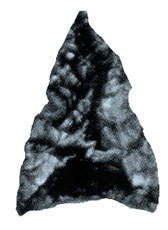Obsidian
Obsidian is a naturally occurring volcanic glass formed as an extrusive igneous rock. It is produced when felsic lava extruded from a volcano cools rapidly with minimal crystal growth. Obsidian is commonly found within the margins of rhyolitic lava flows known as obsidian flows, where the chemical composition induces a high viscosity and polymerization degree of the lava. The inhibition of atomic diffusion through this highly viscous and polymerized lava explains the lack of crystal growth. Obsidian is hard and brittle; it therefore fractures with very sharp edges, which had been used in the past in cutting and piercing tools, and has been used experimentally as surgical scalpel blades.
Properties[edit | edit source]
Obsidian is mineral-like, but not a true mineral because its composition is too complex to comprise a single mineral. It is sometimes classified as a mineraloid. Though obsidian is usually dark in color, similar to basalt, its composition is extremely rich in silica (about 65% to 80%), distinguishing it from the darker basalt. Obsidian may also contain patterns of gas bubbles remaining from the lava flow, aligned along layers created as the molten rock was flowing before being cooled. These bubbles can produce interesting effects such as a golden sheen (sheen obsidian) or a rainbow sheen (rainbow obsidian).
Types of Obsidian[edit | edit source]
There are several types of obsidian, including:
- Black Obsidian - The most common form, which is very dark and may appear black.
- Snowflake Obsidian - Characterized by its pattern of spherulites of radial cristobalite in a matrix of black glass.
- Mahogany Obsidian - Has a reddish-brown color with streaks of black or dark brown, resembling mahogany wood.
- Sheen Obsidian - Contains gas bubbles that create a sheen or glow when viewed from certain angles.
- Rainbow Obsidian - Contains layers of nanoscopic magnetite crystals, giving it a multicolored iridescence.
Formation and Sources[edit | edit source]
Obsidian is formed from quickly cooled lava, which is the parent material. Extrusive formation occurs when this type of lava cools so rapidly that atoms are unable to arrange into a crystalline structure. The rapid cooling (quenching) leads to the formation of a glassy, non-crystalline rock. The presence of water can increase the viscosity of the lava, contributing to the formation of obsidian. Major sources of obsidian include areas with rhyolitic eruptions, such as parts of Argentina, Armenia, Ethiopia, Iceland, Italy, Mexico, Peru, and the United States, particularly in the states of Oregon, California, Idaho, and Wyoming.
Uses[edit | edit source]
Historically, obsidian was used by prehistoric peoples for the production of sharp blades, arrowheads, and sculptures due to its conchoidal fracture, which allows for the creation of sharp edges. In modern times, it has found use in decorative items and jewelry, due to its unique appearance, especially when polished. Obsidian's sharpness has also been utilized in precise surgical instruments, although this application is more experimental.
Cultural Significance[edit | edit source]
Obsidian has held significant cultural value in various ancient societies, including the Maya, the Aztecs, and Native American tribes. It was often used in ritual contexts and as a material for tools and weapons. The reflective surface of obsidian led to its use in divination and as a symbol of mystical insight in some cultures.
Search WikiMD
Ad.Tired of being Overweight? Try W8MD's physician weight loss program.
Semaglutide (Ozempic / Wegovy and Tirzepatide (Mounjaro / Zepbound) available.
Advertise on WikiMD
|
WikiMD's Wellness Encyclopedia |
| Let Food Be Thy Medicine Medicine Thy Food - Hippocrates |
Translate this page: - East Asian
中文,
日本,
한국어,
South Asian
हिन्दी,
தமிழ்,
తెలుగు,
Urdu,
ಕನ್ನಡ,
Southeast Asian
Indonesian,
Vietnamese,
Thai,
မြန်မာဘာသာ,
বাংলা
European
español,
Deutsch,
français,
Greek,
português do Brasil,
polski,
română,
русский,
Nederlands,
norsk,
svenska,
suomi,
Italian
Middle Eastern & African
عربى,
Turkish,
Persian,
Hebrew,
Afrikaans,
isiZulu,
Kiswahili,
Other
Bulgarian,
Hungarian,
Czech,
Swedish,
മലയാളം,
मराठी,
ਪੰਜਾਬੀ,
ગુજરાતી,
Portuguese,
Ukrainian
Medical Disclaimer: WikiMD is not a substitute for professional medical advice. The information on WikiMD is provided as an information resource only, may be incorrect, outdated or misleading, and is not to be used or relied on for any diagnostic or treatment purposes. Please consult your health care provider before making any healthcare decisions or for guidance about a specific medical condition. WikiMD expressly disclaims responsibility, and shall have no liability, for any damages, loss, injury, or liability whatsoever suffered as a result of your reliance on the information contained in this site. By visiting this site you agree to the foregoing terms and conditions, which may from time to time be changed or supplemented by WikiMD. If you do not agree to the foregoing terms and conditions, you should not enter or use this site. See full disclaimer.
Credits:Most images are courtesy of Wikimedia commons, and templates, categories Wikipedia, licensed under CC BY SA or similar.
Contributors: Prab R. Tumpati, MD






